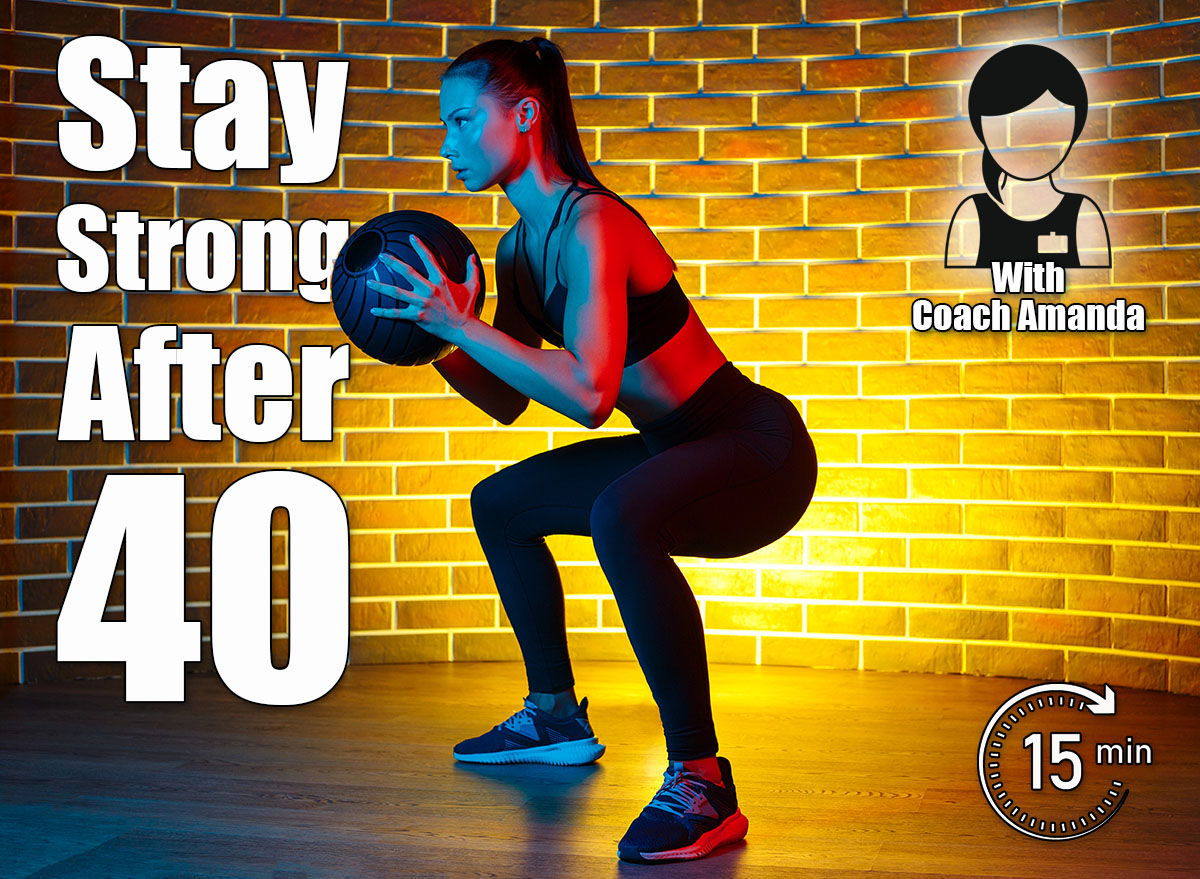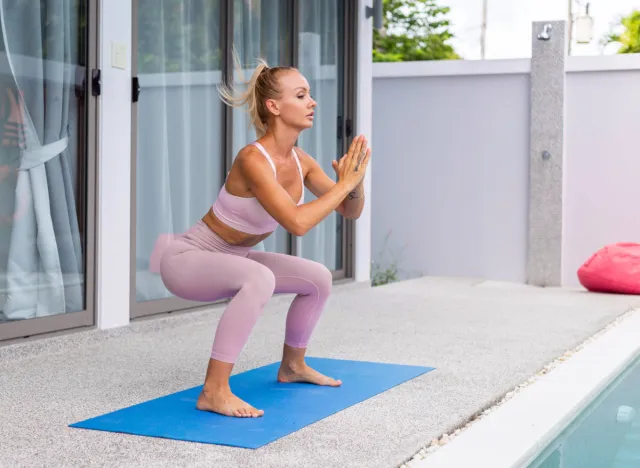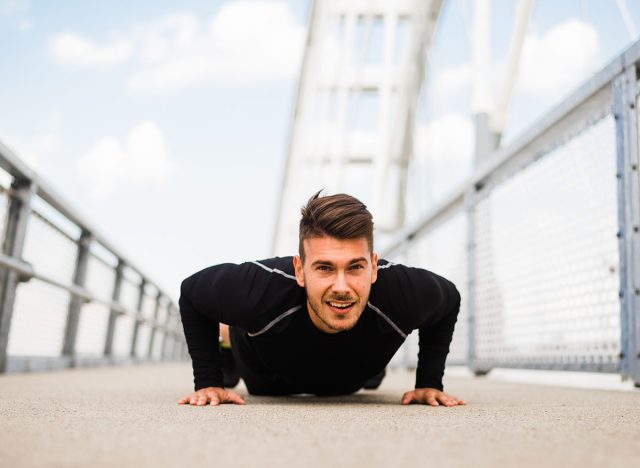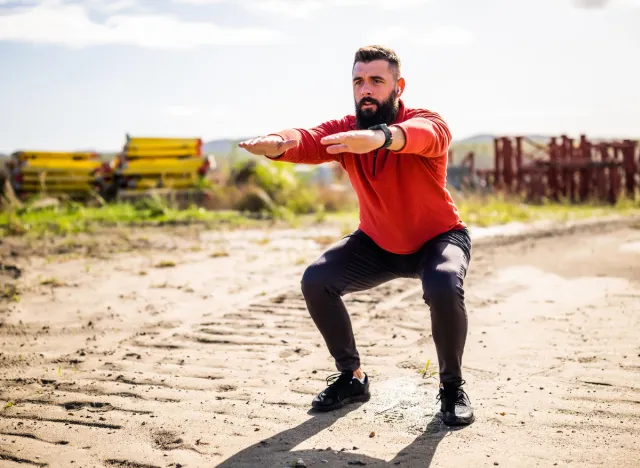4 Essential Exercises Everyone Over 40 Should Do to Stay Strong for Life

Once you reach the 40 milestone, building and maintaining your strength becomes more important than ever. Staying strong as you age will help you remain independent, protect your joints, and keep your body fit and functional for decades to come. However, with all the information online, it can be overwhelming to know where to start. That’s why we chatted with Amanda Dvorak, CPT, a certified personal trainer at Garage Gym Reviews, who shares her four essential exercises that those over 40 should do to stay strong for life.
Regular strength training can help you maintain (and even build) muscle well into your later years. According to the National Institutes of Health, resistance training in older adults can help slow natural muscle loss that occurs with aging while also improving mobility, reducing fall risk, and boosting quality of life.
These four key exercises are ultra-effective as they’re easy to modify, require little or no equipment, and engage multiple muscle groups at once. This means you can get plenty of benefits in a short amount of time, whether you’re at home, traveling, or in the gym.
Here’s exactly how to perform each one, along with tips for proper form, reps, and sets.
(Next up: Be sure to check out these 6 Standing Moves That Build Strength Without Getting on the Floor After 50.)
4 Essential Exercises To Stay Strong After 40
Squats

For anyone looking to get stronger, squats are an absolute must. They strengthen your glutes, quads, hamstrings, and core, all of which are crucial for walking, climbing stairs, and standing up from a seated position. Plus, stronger legs mean more stability and less risk of falls as you age.
“Squats are one of the best ways to maintain lower body strength and mobility,” Dvorak says. “They keep your hips, knees, and ankles working together, which helps with balance and everyday movement.”
How to do it:
- Stand with feet shoulder-width apart and your toes slightly turned out.
- Keep your chest tall and core tight.
- Bend your knees and push your hips back as if sitting into a chair.
- Lower until your thighs are parallel to the floor (or as low as you can).
- Press through your heels to return to the standing position.
Sets & Reps: 3 sets of 10 to 15 reps. Rest for 60 to 90 seconds between sets.
Tip: As you get stronger, you can hold light dumbbells or a kettlebell for added resistance.
Pushups

This classic bodyweight exercise has stood the test of time for a reason: Pushups develop upper-body pushing strength and core stability. “Pushups build strength in your chest, shoulders, arms, and core. They’re also easy to modify by dropping to your knees if needed or elevating your hands,” Dvorak explains.
How to do it:
- Get in a high plank position with your hands slightly wider than shoulder-width apart.
- Keep your body in a straight line from head to toe.
- Bend your elbows to lower your chest toward the floor while keeping them at about a 45-degree angle from your torso.
- Press through your palms to return to the starting position.
Sets & Reps: 3 sets of 8 to 12 reps. Rest for 60 to 90 seconds between sets.
Modification: If regular pushups are too difficult, perform them on your knees or with your hands on an elevated surface, such as a bench or countertop.
Rows

Rows are a pulling exercise that strengthens the muscles between your shoulder blades, lats, and biceps. They’re essential for balancing the front-to-back strength of your upper body, which Harvard Health says can help counteract the rounded posture many people develop from sitting.
“Whether with resistance bands or a suspension trainer, rows pull your shoulders back and strengthen your upper back and arms,” Dvorak says. “This helps fight poor posture and keeps your shoulder joints healthy.”
How to do it (band version):
- Anchor a resistance band to a secure object at chest height.
- Hold the ends with your palms facing each other.
- Step back to create light tension in the band.
- Pull the band toward your ribcage, squeezing your shoulder blades together.
- Slowly return to the starting position.
Sets & Reps: 3 sets of 10 to 15 reps. Rest for 60 to 90 seconds between sets.
Tip: Keep your shoulders down and away from your ears throughout the movement.
Planks
Planks are a highly effective isometric exercise, meaning you hold the position instead of moving. They engage your deep core muscles, glutes, shoulders, and back, training them to work together to stabilize your spine.
“Planks challenge your core in a way that helps prevent back pain and improves posture,” Dvorak explains. “They also build full-body tension and stability.”
How to do it:
- Lie face down and place your forearms on the floor with your elbows under your shoulders.
- Lift your body off the floor so you’re supported on your forearms and toes.
- Keep your body in a straight line from head to toe.
- Keep your body flexed to avoid sagging or piking at your hips.
Sets & Time: Start with 3 sets of 20 to 30-second planks, working up to 60 seconds per set.
Tip: Keep your neck neutral by looking at the floor rather than forward.
Connect the Dots

These four exercises work all the major muscle groups and support the movement patterns you use every day. For a simple, effective full-body workout, perform them in a circuit like so:
- Squats: 10 to 15 reps
- Pushups: 8 to 12 reps
- Rows: 10 to 15 reps
- Plank: 20 to 60-second hold.
Rest for 30 to 60 seconds between exercises and repeat the full circuit three or four times. If you stay consistent with this routine, you’ll significantly increase your chances of staying strong for life.
Looking for more easy ways to lose fat? Here’s How Long Your Walking Workout Should Be To Shrink Belly Fat.